Corporate Accounting: Goodwill Measurement and Business Combination
VerifiedAdded on 2023/01/16
|10
|2233
|62
Report
AI Summary
This report delves into the intricacies of corporate accounting, focusing on the recognition and measurement of goodwill and gain amounts arising from business combinations, as per AASB-3/IFRS-3. The report is divided into two parts: the first part provides an essay on the principles of goodwill accounting and the second part presents a numerical analysis of the acquisition of Davis Ltd. by Alma Ltd. The analysis includes the calculation of net fair value, the determination of goodwill or gain, and the preparation of acquisition analysis and consolidation worksheet entries. The report explains the key aspects of AASB-3, including the definition of business combinations, the measurement of consideration transferred, the treatment of non-controlling interests, and the recognition of bargain purchases. The report also provides a detailed case study involving the acquisition of Davis Ltd., including the calculation of goodwill and the journal entries required to record the transaction. The report concludes with a summary of the key concepts and their practical applications in corporate accounting.
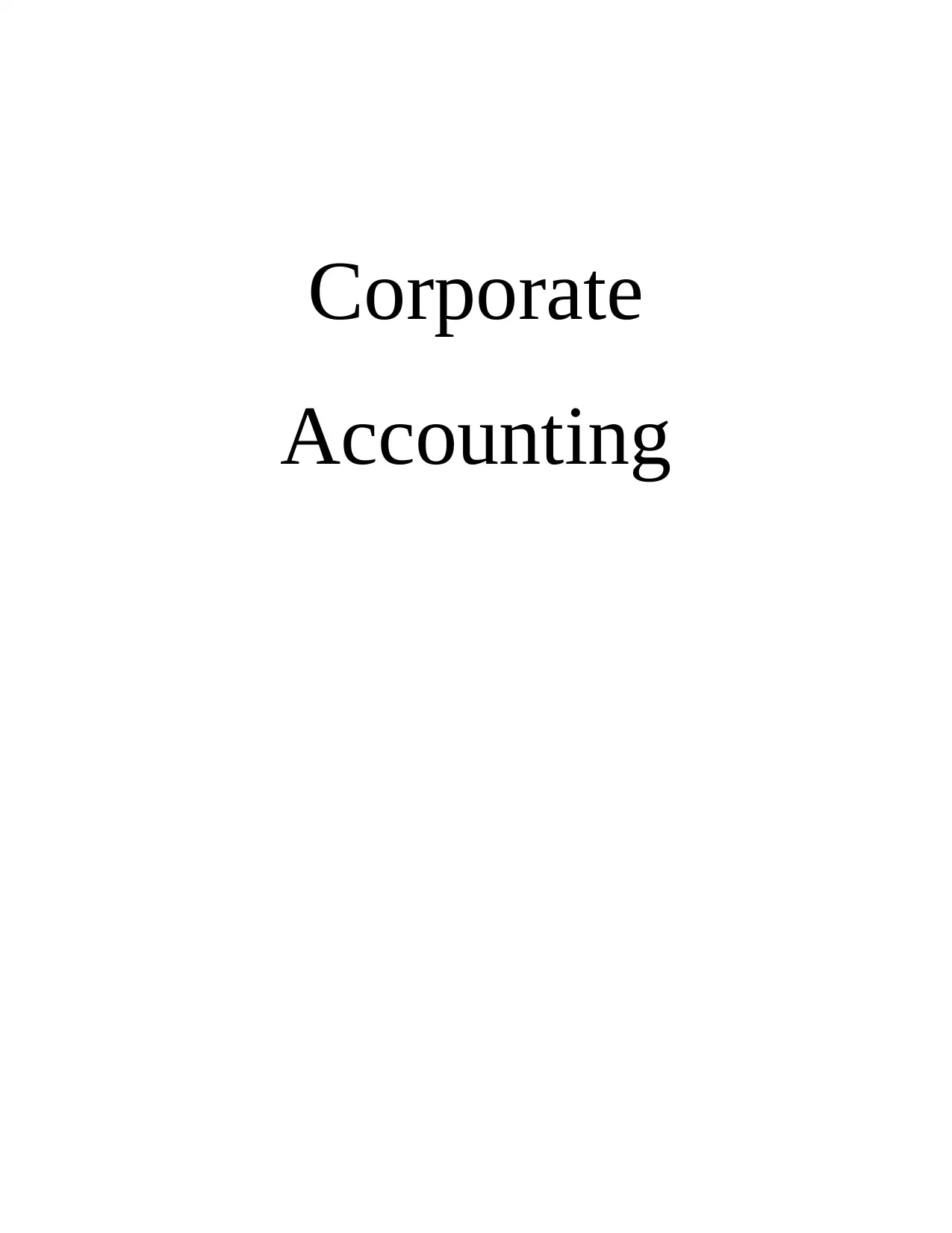
Corporate
Accounting
Accounting
Paraphrase This Document
Need a fresh take? Get an instant paraphrase of this document with our AI Paraphraser
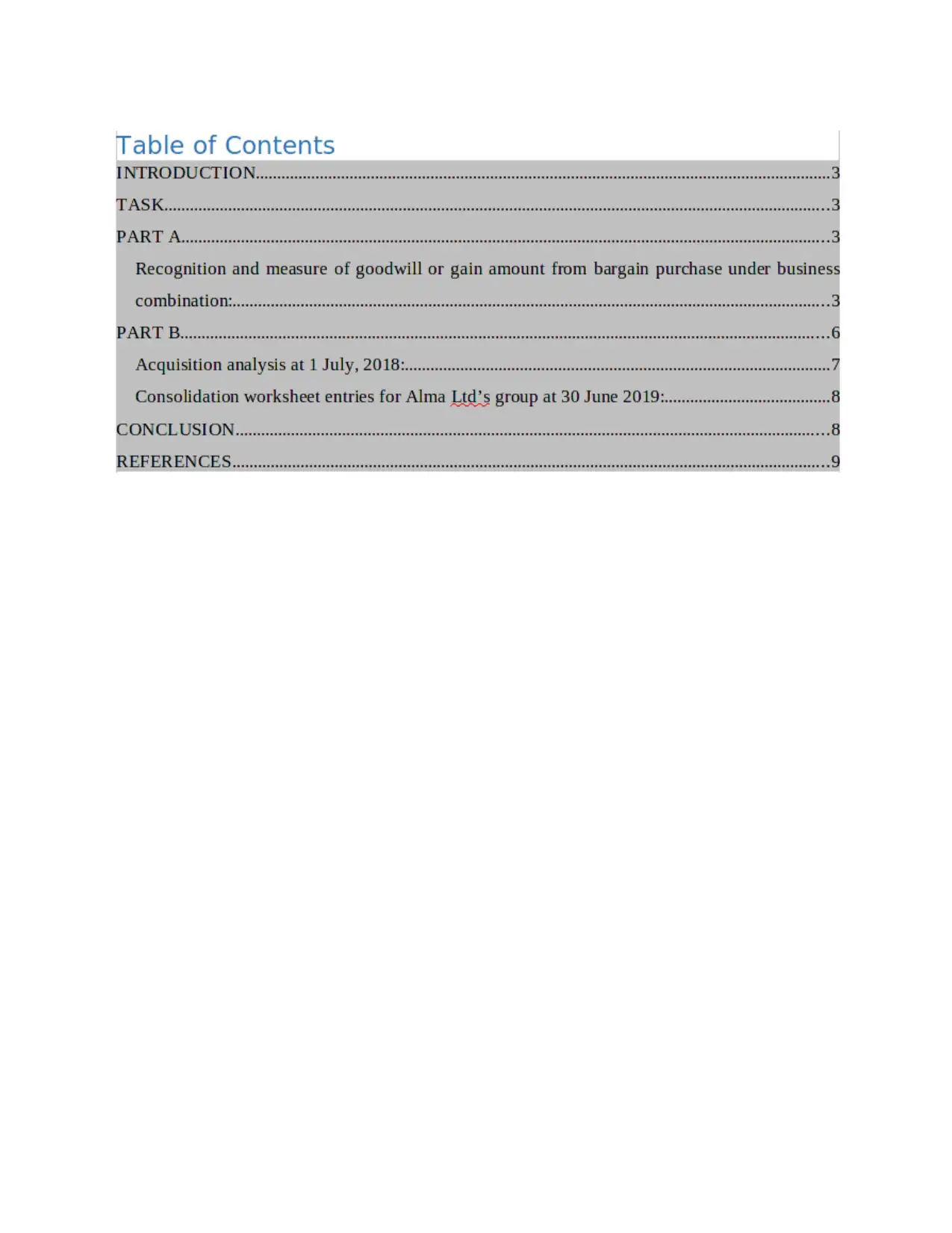
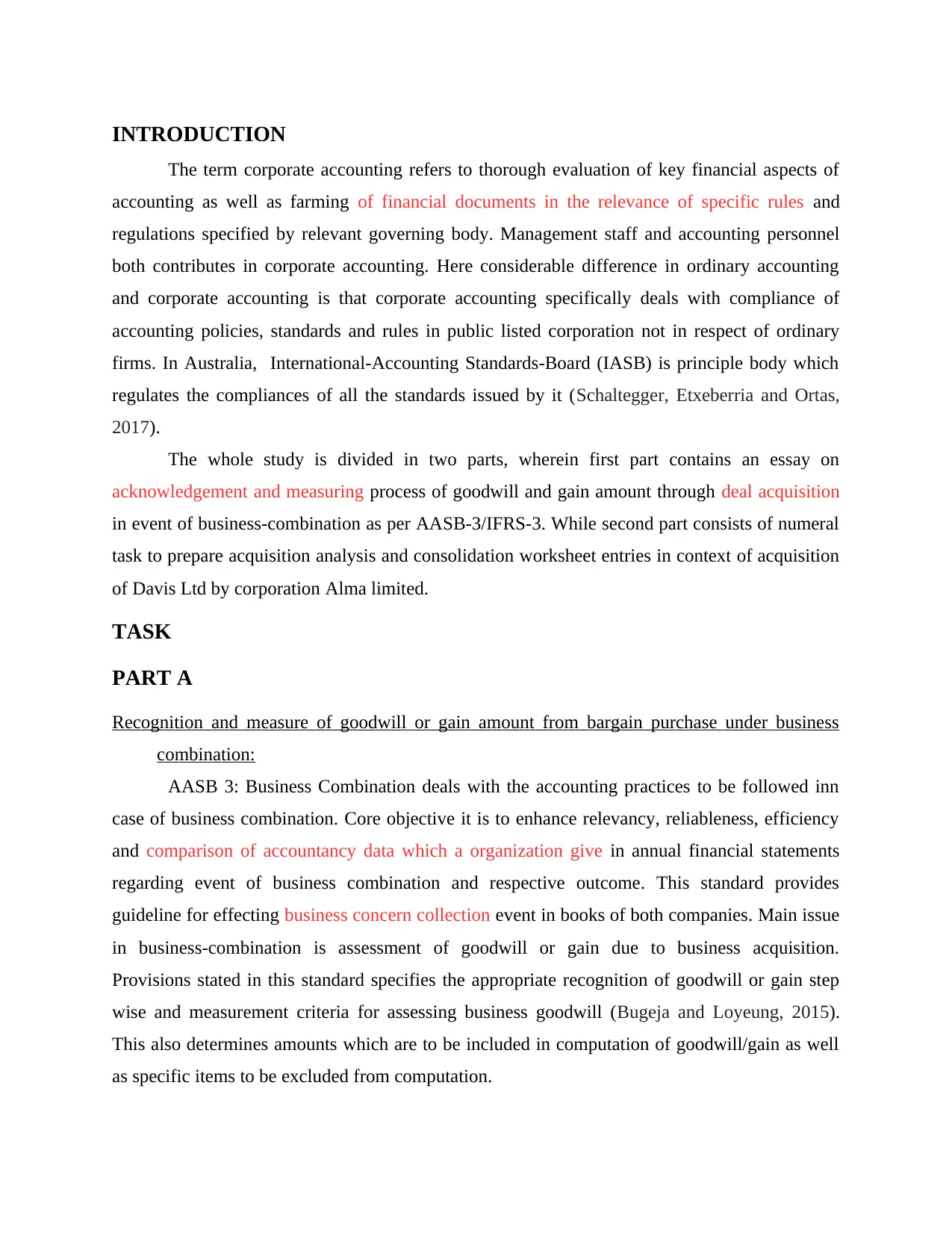
INTRODUCTION
The term corporate accounting refers to thorough evaluation of key financial aspects of
accounting as well as farming of financial documents in the relevance of specific rules and
regulations specified by relevant governing body. Management staff and accounting personnel
both contributes in corporate accounting. Here considerable difference in ordinary accounting
and corporate accounting is that corporate accounting specifically deals with compliance of
accounting policies, standards and rules in public listed corporation not in respect of ordinary
firms. In Australia, International-Accounting Standards-Board (IASB) is principle body which
regulates the compliances of all the standards issued by it (Schaltegger, Etxeberria and Ortas,
2017).
The whole study is divided in two parts, wherein first part contains an essay on
acknowledgement and measuring process of goodwill and gain amount through deal acquisition
in event of business-combination as per AASB-3/IFRS-3. While second part consists of numeral
task to prepare acquisition analysis and consolidation worksheet entries in context of acquisition
of Davis Ltd by corporation Alma limited.
TASK
PART A
Recognition and measure of goodwill or gain amount from bargain purchase under business
combination:
AASB 3: Business Combination deals with the accounting practices to be followed inn
case of business combination. Core objective it is to enhance relevancy, reliableness, efficiency
and comparison of accountancy data which a organization give in annual financial statements
regarding event of business combination and respective outcome. This standard provides
guideline for effecting business concern collection event in books of both companies. Main issue
in business-combination is assessment of goodwill or gain due to business acquisition.
Provisions stated in this standard specifies the appropriate recognition of goodwill or gain step
wise and measurement criteria for assessing business goodwill (Bugeja and Loyeung, 2015).
This also determines amounts which are to be included in computation of goodwill/gain as well
as specific items to be excluded from computation.
The term corporate accounting refers to thorough evaluation of key financial aspects of
accounting as well as farming of financial documents in the relevance of specific rules and
regulations specified by relevant governing body. Management staff and accounting personnel
both contributes in corporate accounting. Here considerable difference in ordinary accounting
and corporate accounting is that corporate accounting specifically deals with compliance of
accounting policies, standards and rules in public listed corporation not in respect of ordinary
firms. In Australia, International-Accounting Standards-Board (IASB) is principle body which
regulates the compliances of all the standards issued by it (Schaltegger, Etxeberria and Ortas,
2017).
The whole study is divided in two parts, wherein first part contains an essay on
acknowledgement and measuring process of goodwill and gain amount through deal acquisition
in event of business-combination as per AASB-3/IFRS-3. While second part consists of numeral
task to prepare acquisition analysis and consolidation worksheet entries in context of acquisition
of Davis Ltd by corporation Alma limited.
TASK
PART A
Recognition and measure of goodwill or gain amount from bargain purchase under business
combination:
AASB 3: Business Combination deals with the accounting practices to be followed inn
case of business combination. Core objective it is to enhance relevancy, reliableness, efficiency
and comparison of accountancy data which a organization give in annual financial statements
regarding event of business combination and respective outcome. This standard provides
guideline for effecting business concern collection event in books of both companies. Main issue
in business-combination is assessment of goodwill or gain due to business acquisition.
Provisions stated in this standard specifies the appropriate recognition of goodwill or gain step
wise and measurement criteria for assessing business goodwill (Bugeja and Loyeung, 2015).
This also determines amounts which are to be included in computation of goodwill/gain as well
as specific items to be excluded from computation.
⊘ This is a preview!⊘
Do you want full access?
Subscribe today to unlock all pages.

Trusted by 1+ million students worldwide
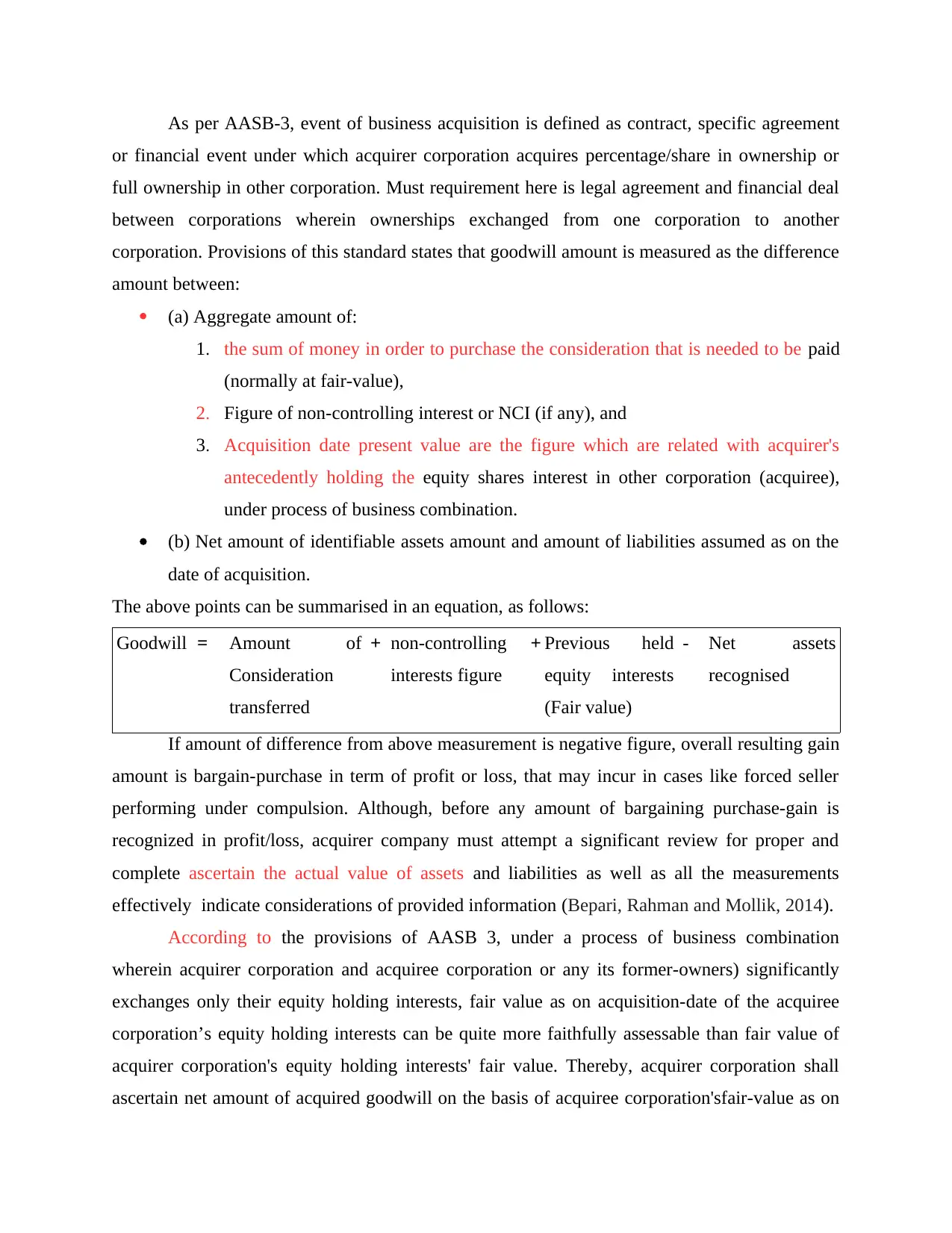
As per AASB-3, event of business acquisition is defined as contract, specific agreement
or financial event under which acquirer corporation acquires percentage/share in ownership or
full ownership in other corporation. Must requirement here is legal agreement and financial deal
between corporations wherein ownerships exchanged from one corporation to another
corporation. Provisions of this standard states that goodwill amount is measured as the difference
amount between:
(a) Aggregate amount of:
1. the sum of money in order to purchase the consideration that is needed to be paid
(normally at fair-value),
2. Figure of non-controlling interest or NCI (if any), and
3. Acquisition date present value are the figure which are related with acquirer's
antecedently holding the equity shares interest in other corporation (acquiree),
under process of business combination.
(b) Net amount of identifiable assets amount and amount of liabilities assumed as on the
date of acquisition.
The above points can be summarised in an equation, as follows:
Goodwill = Amount of
Consideration
transferred
+ non-controlling
interests figure
+ Previous held
equity interests
(Fair value)
- Net assets
recognised
If amount of difference from above measurement is negative figure, overall resulting gain
amount is bargain-purchase in term of profit or loss, that may incur in cases like forced seller
performing under compulsion. Although, before any amount of bargaining purchase-gain is
recognized in profit/loss, acquirer company must attempt a significant review for proper and
complete ascertain the actual value of assets and liabilities as well as all the measurements
effectively indicate considerations of provided information (Bepari, Rahman and Mollik, 2014).
According to the provisions of AASB 3, under a process of business combination
wherein acquirer corporation and acquiree corporation or any its former-owners) significantly
exchanges only their equity holding interests, fair value as on acquisition-date of the acquiree
corporation’s equity holding interests can be quite more faithfully assessable than fair value of
acquirer corporation's equity holding interests' fair value. Thereby, acquirer corporation shall
ascertain net amount of acquired goodwill on the basis of acquiree corporation'sfair-value as on
or financial event under which acquirer corporation acquires percentage/share in ownership or
full ownership in other corporation. Must requirement here is legal agreement and financial deal
between corporations wherein ownerships exchanged from one corporation to another
corporation. Provisions of this standard states that goodwill amount is measured as the difference
amount between:
(a) Aggregate amount of:
1. the sum of money in order to purchase the consideration that is needed to be paid
(normally at fair-value),
2. Figure of non-controlling interest or NCI (if any), and
3. Acquisition date present value are the figure which are related with acquirer's
antecedently holding the equity shares interest in other corporation (acquiree),
under process of business combination.
(b) Net amount of identifiable assets amount and amount of liabilities assumed as on the
date of acquisition.
The above points can be summarised in an equation, as follows:
Goodwill = Amount of
Consideration
transferred
+ non-controlling
interests figure
+ Previous held
equity interests
(Fair value)
- Net assets
recognised
If amount of difference from above measurement is negative figure, overall resulting gain
amount is bargain-purchase in term of profit or loss, that may incur in cases like forced seller
performing under compulsion. Although, before any amount of bargaining purchase-gain is
recognized in profit/loss, acquirer company must attempt a significant review for proper and
complete ascertain the actual value of assets and liabilities as well as all the measurements
effectively indicate considerations of provided information (Bepari, Rahman and Mollik, 2014).
According to the provisions of AASB 3, under a process of business combination
wherein acquirer corporation and acquiree corporation or any its former-owners) significantly
exchanges only their equity holding interests, fair value as on acquisition-date of the acquiree
corporation’s equity holding interests can be quite more faithfully assessable than fair value of
acquirer corporation's equity holding interests' fair value. Thereby, acquirer corporation shall
ascertain net amount of acquired goodwill on the basis of acquiree corporation'sfair-value as on
Paraphrase This Document
Need a fresh take? Get an instant paraphrase of this document with our AI Paraphraser
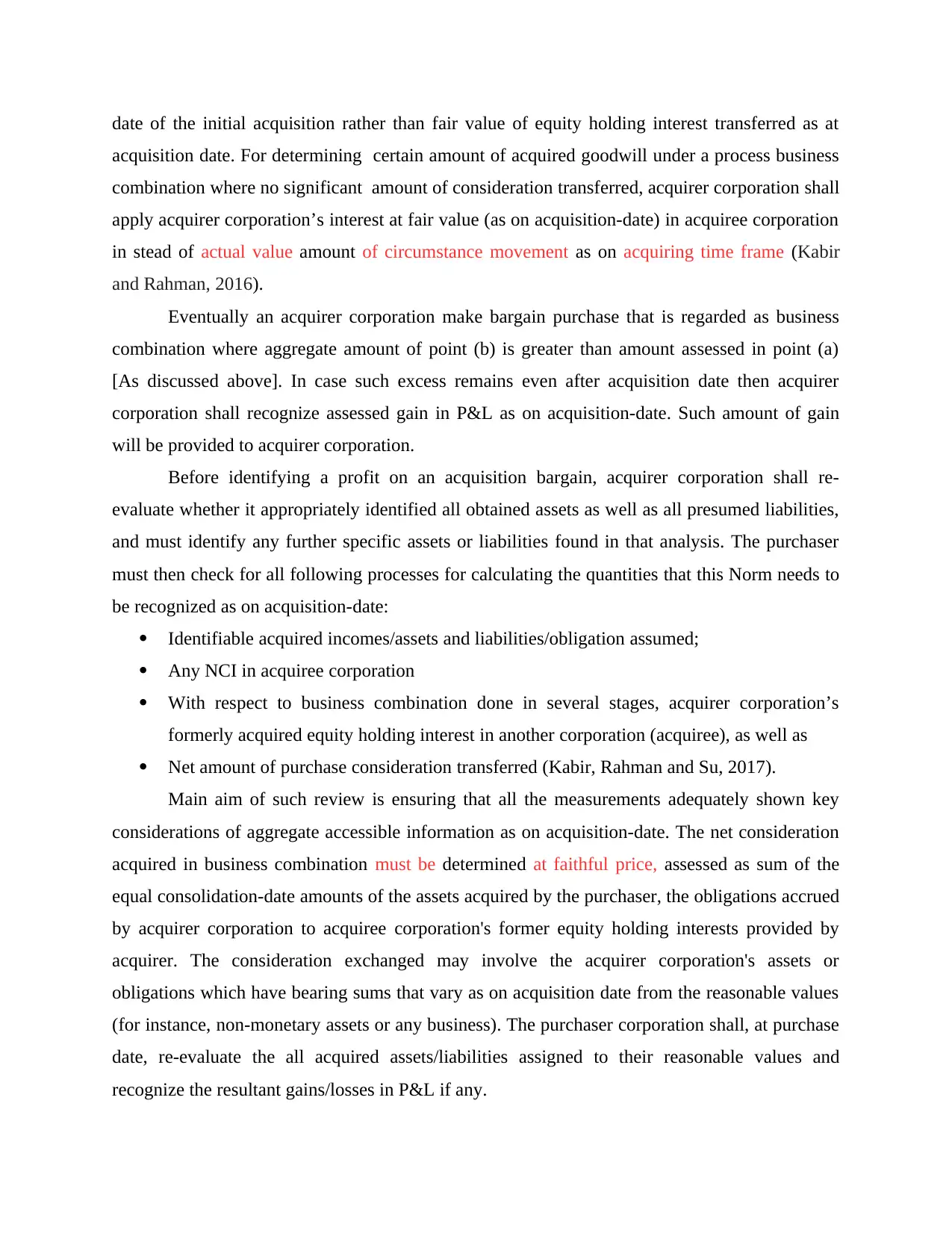
date of the initial acquisition rather than fair value of equity holding interest transferred as at
acquisition date. For determining certain amount of acquired goodwill under a process business
combination where no significant amount of consideration transferred, acquirer corporation shall
apply acquirer corporation’s interest at fair value (as on acquisition-date) in acquiree corporation
in stead of actual value amount of circumstance movement as on acquiring time frame (Kabir
and Rahman, 2016).
Eventually an acquirer corporation make bargain purchase that is regarded as business
combination where aggregate amount of point (b) is greater than amount assessed in point (a)
[As discussed above]. In case such excess remains even after acquisition date then acquirer
corporation shall recognize assessed gain in P&L as on acquisition-date. Such amount of gain
will be provided to acquirer corporation.
Before identifying a profit on an acquisition bargain, acquirer corporation shall re-
evaluate whether it appropriately identified all obtained assets as well as all presumed liabilities,
and must identify any further specific assets or liabilities found in that analysis. The purchaser
must then check for all following processes for calculating the quantities that this Norm needs to
be recognized as on acquisition-date:
Identifiable acquired incomes/assets and liabilities/obligation assumed;
Any NCI in acquiree corporation
With respect to business combination done in several stages, acquirer corporation’s
formerly acquired equity holding interest in another corporation (acquiree), as well as
Net amount of purchase consideration transferred (Kabir, Rahman and Su, 2017).
Main aim of such review is ensuring that all the measurements adequately shown key
considerations of aggregate accessible information as on acquisition-date. The net consideration
acquired in business combination must be determined at faithful price, assessed as sum of the
equal consolidation-date amounts of the assets acquired by the purchaser, the obligations accrued
by acquirer corporation to acquiree corporation's former equity holding interests provided by
acquirer. The consideration exchanged may involve the acquirer corporation's assets or
obligations which have bearing sums that vary as on acquisition date from the reasonable values
(for instance, non-monetary assets or any business). The purchaser corporation shall, at purchase
date, re-evaluate the all acquired assets/liabilities assigned to their reasonable values and
recognize the resultant gains/losses in P&L if any.
acquisition date. For determining certain amount of acquired goodwill under a process business
combination where no significant amount of consideration transferred, acquirer corporation shall
apply acquirer corporation’s interest at fair value (as on acquisition-date) in acquiree corporation
in stead of actual value amount of circumstance movement as on acquiring time frame (Kabir
and Rahman, 2016).
Eventually an acquirer corporation make bargain purchase that is regarded as business
combination where aggregate amount of point (b) is greater than amount assessed in point (a)
[As discussed above]. In case such excess remains even after acquisition date then acquirer
corporation shall recognize assessed gain in P&L as on acquisition-date. Such amount of gain
will be provided to acquirer corporation.
Before identifying a profit on an acquisition bargain, acquirer corporation shall re-
evaluate whether it appropriately identified all obtained assets as well as all presumed liabilities,
and must identify any further specific assets or liabilities found in that analysis. The purchaser
must then check for all following processes for calculating the quantities that this Norm needs to
be recognized as on acquisition-date:
Identifiable acquired incomes/assets and liabilities/obligation assumed;
Any NCI in acquiree corporation
With respect to business combination done in several stages, acquirer corporation’s
formerly acquired equity holding interest in another corporation (acquiree), as well as
Net amount of purchase consideration transferred (Kabir, Rahman and Su, 2017).
Main aim of such review is ensuring that all the measurements adequately shown key
considerations of aggregate accessible information as on acquisition-date. The net consideration
acquired in business combination must be determined at faithful price, assessed as sum of the
equal consolidation-date amounts of the assets acquired by the purchaser, the obligations accrued
by acquirer corporation to acquiree corporation's former equity holding interests provided by
acquirer. The consideration exchanged may involve the acquirer corporation's assets or
obligations which have bearing sums that vary as on acquisition date from the reasonable values
(for instance, non-monetary assets or any business). The purchaser corporation shall, at purchase
date, re-evaluate the all acquired assets/liabilities assigned to their reasonable values and
recognize the resultant gains/losses in P&L if any.
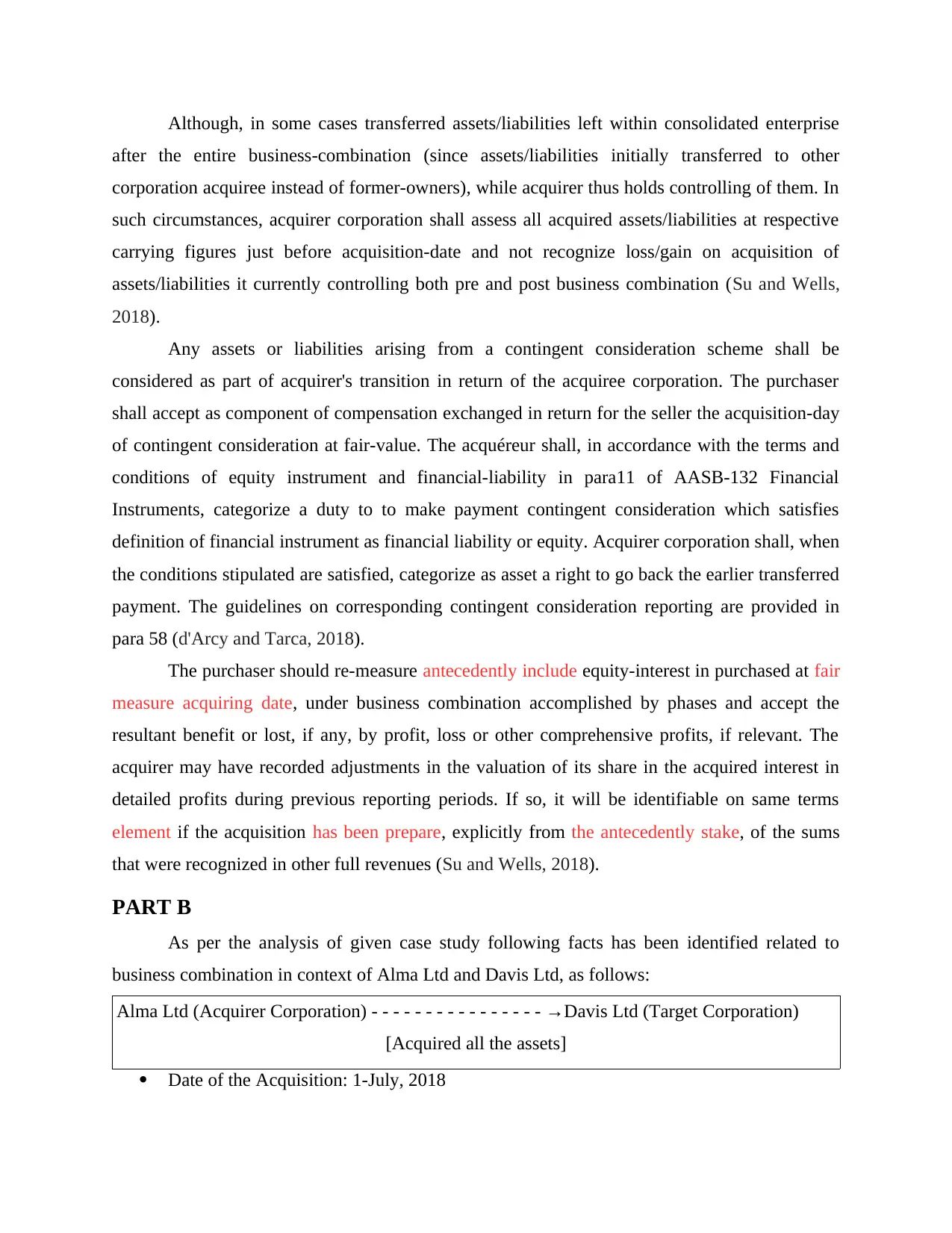
Although, in some cases transferred assets/liabilities left within consolidated enterprise
after the entire business-combination (since assets/liabilities initially transferred to other
corporation acquiree instead of former-owners), while acquirer thus holds controlling of them. In
such circumstances, acquirer corporation shall assess all acquired assets/liabilities at respective
carrying figures just before acquisition-date and not recognize loss/gain on acquisition of
assets/liabilities it currently controlling both pre and post business combination (Su and Wells,
2018).
Any assets or liabilities arising from a contingent consideration scheme shall be
considered as part of acquirer's transition in return of the acquiree corporation. The purchaser
shall accept as component of compensation exchanged in return for the seller the acquisition-day
of contingent consideration at fair-value. The acquéreur shall, in accordance with the terms and
conditions of equity instrument and financial-liability in para11 of AASB-132 Financial
Instruments, categorize a duty to to make payment contingent consideration which satisfies
definition of financial instrument as financial liability or equity. Acquirer corporation shall, when
the conditions stipulated are satisfied, categorize as asset a right to go back the earlier transferred
payment. The guidelines on corresponding contingent consideration reporting are provided in
para 58 (d'Arcy and Tarca, 2018).
The purchaser should re-measure antecedently include equity-interest in purchased at fair
measure acquiring date, under business combination accomplished by phases and accept the
resultant benefit or lost, if any, by profit, loss or other comprehensive profits, if relevant. The
acquirer may have recorded adjustments in the valuation of its share in the acquired interest in
detailed profits during previous reporting periods. If so, it will be identifiable on same terms
element if the acquisition has been prepare, explicitly from the antecedently stake, of the sums
that were recognized in other full revenues (Su and Wells, 2018).
PART B
As per the analysis of given case study following facts has been identified related to
business combination in context of Alma Ltd and Davis Ltd, as follows:
Alma Ltd (Acquirer Corporation) - - - - - - - - - - - - - - - - →Davis Ltd (Target Corporation)
[Acquired all the assets]
Date of the Acquisition: 1-July, 2018
after the entire business-combination (since assets/liabilities initially transferred to other
corporation acquiree instead of former-owners), while acquirer thus holds controlling of them. In
such circumstances, acquirer corporation shall assess all acquired assets/liabilities at respective
carrying figures just before acquisition-date and not recognize loss/gain on acquisition of
assets/liabilities it currently controlling both pre and post business combination (Su and Wells,
2018).
Any assets or liabilities arising from a contingent consideration scheme shall be
considered as part of acquirer's transition in return of the acquiree corporation. The purchaser
shall accept as component of compensation exchanged in return for the seller the acquisition-day
of contingent consideration at fair-value. The acquéreur shall, in accordance with the terms and
conditions of equity instrument and financial-liability in para11 of AASB-132 Financial
Instruments, categorize a duty to to make payment contingent consideration which satisfies
definition of financial instrument as financial liability or equity. Acquirer corporation shall, when
the conditions stipulated are satisfied, categorize as asset a right to go back the earlier transferred
payment. The guidelines on corresponding contingent consideration reporting are provided in
para 58 (d'Arcy and Tarca, 2018).
The purchaser should re-measure antecedently include equity-interest in purchased at fair
measure acquiring date, under business combination accomplished by phases and accept the
resultant benefit or lost, if any, by profit, loss or other comprehensive profits, if relevant. The
acquirer may have recorded adjustments in the valuation of its share in the acquired interest in
detailed profits during previous reporting periods. If so, it will be identifiable on same terms
element if the acquisition has been prepare, explicitly from the antecedently stake, of the sums
that were recognized in other full revenues (Su and Wells, 2018).
PART B
As per the analysis of given case study following facts has been identified related to
business combination in context of Alma Ltd and Davis Ltd, as follows:
Alma Ltd (Acquirer Corporation) - - - - - - - - - - - - - - - - →Davis Ltd (Target Corporation)
[Acquired all the assets]
Date of the Acquisition: 1-July, 2018
⊘ This is a preview!⊘
Do you want full access?
Subscribe today to unlock all pages.

Trusted by 1+ million students worldwide
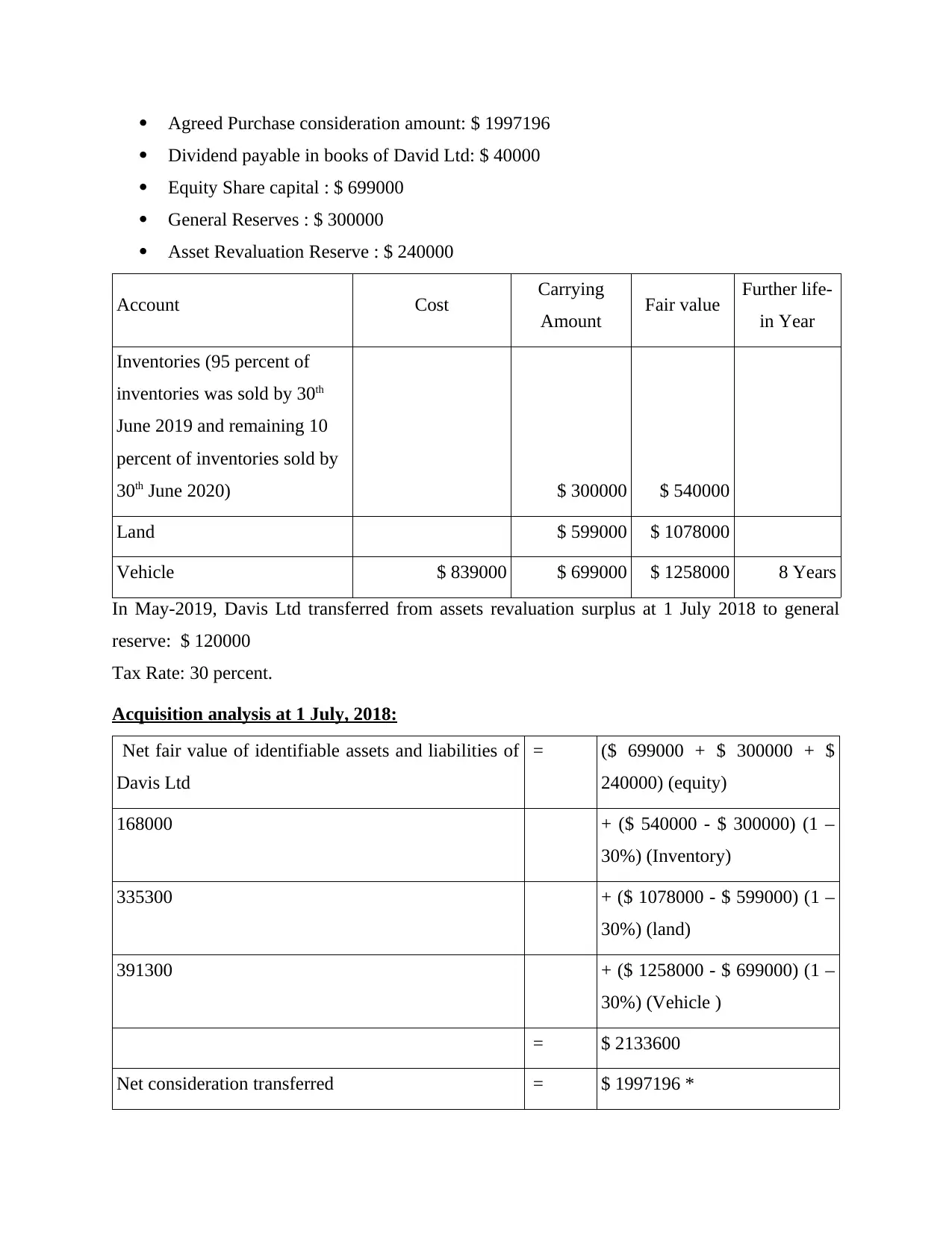
Agreed Purchase consideration amount: $ 1997196
Dividend payable in books of David Ltd: $ 40000
Equity Share capital : $ 699000
General Reserves : $ 300000
Asset Revaluation Reserve : $ 240000
Account Cost Carrying
Amount Fair value Further life-
in Year
Inventories (95 percent of
inventories was sold by 30th
June 2019 and remaining 10
percent of inventories sold by
30th June 2020) $ 300000 $ 540000
Land $ 599000 $ 1078000
Vehicle $ 839000 $ 699000 $ 1258000 8 Years
In May-2019, Davis Ltd transferred from assets revaluation surplus at 1 July 2018 to general
reserve: $ 120000
Tax Rate: 30 percent.
Acquisition analysis at 1 July, 2018:
Net fair value of identifiable assets and liabilities of
Davis Ltd
= ($ 699000 + $ 300000 + $
240000) (equity)
168000 + ($ 540000 - $ 300000) (1 –
30%) (Inventory)
335300 + ($ 1078000 - $ 599000) (1 –
30%) (land)
391300 + ($ 1258000 - $ 699000) (1 –
30%) (Vehicle )
= $ 2133600
Net consideration transferred = $ 1997196 *
Dividend payable in books of David Ltd: $ 40000
Equity Share capital : $ 699000
General Reserves : $ 300000
Asset Revaluation Reserve : $ 240000
Account Cost Carrying
Amount Fair value Further life-
in Year
Inventories (95 percent of
inventories was sold by 30th
June 2019 and remaining 10
percent of inventories sold by
30th June 2020) $ 300000 $ 540000
Land $ 599000 $ 1078000
Vehicle $ 839000 $ 699000 $ 1258000 8 Years
In May-2019, Davis Ltd transferred from assets revaluation surplus at 1 July 2018 to general
reserve: $ 120000
Tax Rate: 30 percent.
Acquisition analysis at 1 July, 2018:
Net fair value of identifiable assets and liabilities of
Davis Ltd
= ($ 699000 + $ 300000 + $
240000) (equity)
168000 + ($ 540000 - $ 300000) (1 –
30%) (Inventory)
335300 + ($ 1078000 - $ 599000) (1 –
30%) (land)
391300 + ($ 1258000 - $ 699000) (1 –
30%) (Vehicle )
= $ 2133600
Net consideration transferred = $ 1997196 *
Paraphrase This Document
Need a fresh take? Get an instant paraphrase of this document with our AI Paraphraser
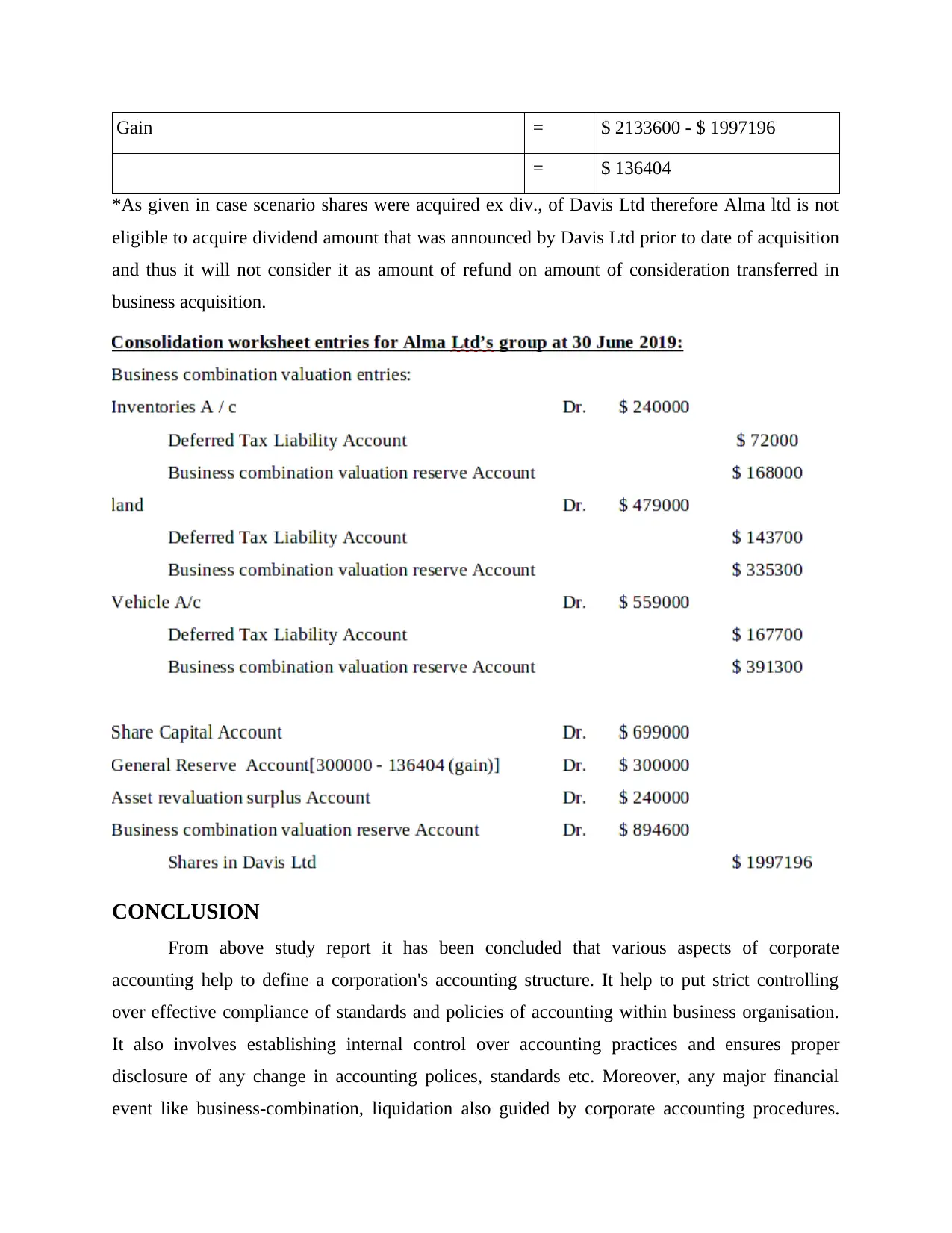
Gain = $ 2133600 - $ 1997196
= $ 136404
*As given in case scenario shares were acquired ex div., of Davis Ltd therefore Alma ltd is not
eligible to acquire dividend amount that was announced by Davis Ltd prior to date of acquisition
and thus it will not consider it as amount of refund on amount of consideration transferred in
business acquisition.
CONCLUSION
From above study report it has been concluded that various aspects of corporate
accounting help to define a corporation's accounting structure. It help to put strict controlling
over effective compliance of standards and policies of accounting within business organisation.
It also involves establishing internal control over accounting practices and ensures proper
disclosure of any change in accounting polices, standards etc. Moreover, any major financial
event like business-combination, liquidation also guided by corporate accounting procedures.
= $ 136404
*As given in case scenario shares were acquired ex div., of Davis Ltd therefore Alma ltd is not
eligible to acquire dividend amount that was announced by Davis Ltd prior to date of acquisition
and thus it will not consider it as amount of refund on amount of consideration transferred in
business acquisition.
CONCLUSION
From above study report it has been concluded that various aspects of corporate
accounting help to define a corporation's accounting structure. It help to put strict controlling
over effective compliance of standards and policies of accounting within business organisation.
It also involves establishing internal control over accounting practices and ensures proper
disclosure of any change in accounting polices, standards etc. Moreover, any major financial
event like business-combination, liquidation also guided by corporate accounting procedures.

Management in listed company coordinate with accounting staff to ensure the effective
compliance of adopted accounting standards and policies.
compliance of adopted accounting standards and policies.
⊘ This is a preview!⊘
Do you want full access?
Subscribe today to unlock all pages.

Trusted by 1+ million students worldwide

REFERENCES
Books and Journals:
Schaltegger, S., Etxeberria, I.Á. and Ortas, E., 2017. Innovating corporate accounting and
reporting for sustainability–attributes and challenges. Sustainable Development. 25(2),
pp. 113-122.
Bugeja, M. and Loyeung, A., 2015. What drives the allocation of the purchase price to
goodwill?. Journal of Contemporary Accounting & Economics. 11(3). pp. 245-261.
Bepari, M.K., Rahman, S.F. and Mollik, A.T., 2014. Firms' compliance with the disclosure
requirements of IFRS for goodwill impairment testing: Effect of the global financial
crisis and other firm characteristics. Journal of Accounting and Organizational
Change. 10(1). pp. 116-149.
Kabir, H. and Rahman, A., 2016. The role of corporate governance in accounting discretion
under IFRS: Goodwill impairment in Australia. Journal of Contemporary Accounting &
Economics. 12(3). pp. 290-308.
Kabir, H., Rahman, A. and Su, L., 2017. The association between goodwill impairment loss and
goodwill impairment test-related disclosures in Australia. In 8th Conference on
Financial Markets and Corporate Governance (FMCG).
Su, W.H. and Wells, P., 2018. Acquisition premiums and the recognition of identifiable
intangible assets in business combinations pre-and post-IFRS adoption. Accounting
Research Journal.
d'Arcy, A. and Tarca, A., 2018. Reviewing IFRS goodwill accounting research: Implementation
effects and cross-country differences. The International Journal of Accounting, 53(3).
pp. 203-226.
Su, W.H. and Wells, P., 2018. Acquisition premiums and the recognition of identifiable
intangible assets in business combinations pre-and post-IFRS adoption. Accounting
Research Journal.
Books and Journals:
Schaltegger, S., Etxeberria, I.Á. and Ortas, E., 2017. Innovating corporate accounting and
reporting for sustainability–attributes and challenges. Sustainable Development. 25(2),
pp. 113-122.
Bugeja, M. and Loyeung, A., 2015. What drives the allocation of the purchase price to
goodwill?. Journal of Contemporary Accounting & Economics. 11(3). pp. 245-261.
Bepari, M.K., Rahman, S.F. and Mollik, A.T., 2014. Firms' compliance with the disclosure
requirements of IFRS for goodwill impairment testing: Effect of the global financial
crisis and other firm characteristics. Journal of Accounting and Organizational
Change. 10(1). pp. 116-149.
Kabir, H. and Rahman, A., 2016. The role of corporate governance in accounting discretion
under IFRS: Goodwill impairment in Australia. Journal of Contemporary Accounting &
Economics. 12(3). pp. 290-308.
Kabir, H., Rahman, A. and Su, L., 2017. The association between goodwill impairment loss and
goodwill impairment test-related disclosures in Australia. In 8th Conference on
Financial Markets and Corporate Governance (FMCG).
Su, W.H. and Wells, P., 2018. Acquisition premiums and the recognition of identifiable
intangible assets in business combinations pre-and post-IFRS adoption. Accounting
Research Journal.
d'Arcy, A. and Tarca, A., 2018. Reviewing IFRS goodwill accounting research: Implementation
effects and cross-country differences. The International Journal of Accounting, 53(3).
pp. 203-226.
Su, W.H. and Wells, P., 2018. Acquisition premiums and the recognition of identifiable
intangible assets in business combinations pre-and post-IFRS adoption. Accounting
Research Journal.
1 out of 10
Related Documents
Your All-in-One AI-Powered Toolkit for Academic Success.
+13062052269
info@desklib.com
Available 24*7 on WhatsApp / Email
![[object Object]](/_next/static/media/star-bottom.7253800d.svg)
Unlock your academic potential
Copyright © 2020–2025 A2Z Services. All Rights Reserved. Developed and managed by ZUCOL.




